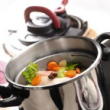Healthy Cooking

Mistakes you are probably making when you make soup
There’s nothing quite like a bowl of steaming soup on a cold day to make you feel warm and cozy. Whether there’s rain pounding outside or a few inches of snow making PJs and a blanket look like the best option, soup is definitely the winning winter meal for lunch or dinner.
While it’s easy to reach for a tin of soup on the supermarket shelf, there’s nothing quite like whipping up a fresh batch that is full of flavour. Not only does it mean you get to use up all the leftover meat and vegetables in your kitchen rather than putting them in the garbage, you can also make enough to freeze so reheating homemade soup is just as easy as opening a tin.
Soup also isn’t too difficult to make, and yet a lot of us make the same mistakes. Not making soup correctly can mean it lacks flavour, is a bit watery and doesn’t quite hit the spot on a cold and wet winter day.

If you want to make the perfect soup, here are some common mistakes you should definitely avoid:
1. Using a weak stock
No one wants a weak and watery gravy with a roast dinner and it’s the same with stock when it comes to soup. Your stock is where a lot of the flavour comes from, so you need to make sure yours is packed full of taste to provide the perfect base. Ditch the stock cubes and try either making your own with meat, vegetables, fish or bones – you can tailor it depending on what soup you’re making and what leftovers you have – or buying a high-quality, pre-made version. Once you have a good stock, you know your soup is going to be delicious.
2. Not sweating your vegetables
Soup really is all about layering up the flavours, so you need to bear this in mind even if you do have a good stock. A great way to introduce more taste to your soup is to start off by sweating aromatic vegetables like garlic, onions, carrots, celery and peppers.Simply chop up your chosen aromatics and put them on a low heat. You don’t want to brown or caramelize them, instead, the idea is to soften them and allow their flavour to be released. This works so much better than just popping your veggies in the pan with the rest of your soup ingredients, as it creates a more layered and complex flavour that you won’t get from tinned soup.
3. Using dried herbs
The chances are you have a selection of dried herbs in your cupboard, which make cooking a lot easier. However, fresh herbs tend to have a lot more flavour and are the perfect choice when cooking soup. Fresh herbs smell and taste great, leaving your mouth watering when you’re both cooking and serving your soup. Rather than putting fresh herbs into the pot in a bundle, chop them as finely and as quickly as possible, as this will release all the oils and flavour. Some fresh herbs start releasing their flavour straight away, so be ready to cut them and get them in with the rest of the ingredients straight away, giving them a good stir. You’ll be amazed at the difference this simple change can make.
4. Overseasoning
Most of the time, you need to season what you’re cooking along the way in order to bring out the best flavours. However, if you do this with soup, you can end up with a super salty bowl that is far from appetising. The combination of stock, vegetables, herbs and meat can add enough saltiness to your soup on its own, so if you keep seasoning throughout the cooking process, you’ll find the flavour totally ruined. This is why you should save the salt and pepper until the cooking process is almost finished.If you’re leaving your soup nice and chunky, add seasoning – a small amount at a time – a few minutes before serving to finish your soup off. However, if you prefer a smooth soup and are popping yours in a blender, don’t season it until you’ve done this as blending it will release more flavours. Always give your soup a taste to see what it needs, as you may be surprised that it is full of flavour without any salt or pepper.

